By Roy Macartney
First published in The Age on July 21, 1969
MAN IS ON THE MOON
Now they’re ready for the walk
Astronauts Neil Armstrong and Edwin Aldrin touched down on the moon today at 6.18 a.m. Melbourne time. The historic lunar module Eagle dropped to the moon’s surface in a cloud of swirling dust raised by its jet engine, which had been cut a second earlier.
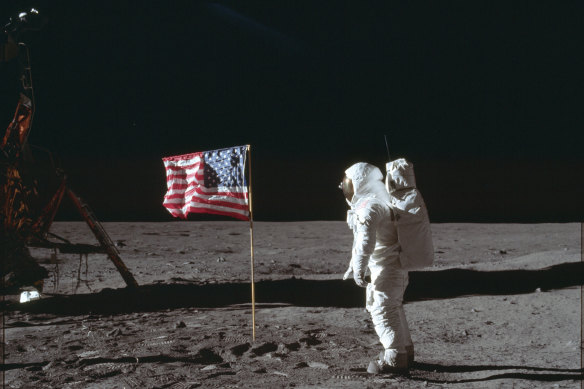
Astronauts Buzz Aldrin and Neil Armstrong making history on July 20, 1969. Credit: NASA
They landed near their target zone in the Sea of Tranquility.
Commander Armstrong immediately flashed the message: “Houston, Eagle has landed.” Back came the reply from Houston: “You’ve got a bunch of guys turning blue. We’re breathing again. Thanks a lot.”
At 20 feet, Eagle had radioed: “We are picking up dust” as the craft went in for final touchdown.
At 6.28, Armstrong radioed back: “That must have seemed like a long landing procedure.”
He explained that the auto landing equipment had been bringing the Eagle down on a “football field sized crater with a large number of big boulders and rocks.”
He said that they had to fly manually over these rocks to find a reasonably good site for touchdown. Armstrong looked out the spaceship window landing and said: “It was beautiful from here, Tranquility. There are two smiling faces up here.”
Armstrong and Aldrin are not scheduled to step down to the moon’s surface until 4.12 p.m. Melbourne time.
But the moon walk could be as early as 9 a.m. Melbourne time today.

Buzz Aldrin deploys an experiment on the surface of the moon.Credit: NASA
This would be nearly seven hours earlier than officially planned.
A decision on the walk time will be made at 7.32 this morning.
Before the walk the astronauts must first check the spacecraft for damage.
Descent to the moon took more than an hour of complex, hair-raising maneuvering.
Astronaut Michael Collins, orbiting overhead in the command spaceship Columbia, could not see the landing, 69 miles below.
Armstrong and Aldrin undocked Eagle from Columbia at 3.42 a.m. Melbourne time.
Collins pressed a button to release the 12 latches holding the two ships together and Eagle swooped towards the moon.
“The Eagle has wings,” said Armstrong who in a few hours will be the first man to walk on the moon.
“A fine machine”
Exactly on time, at 4.12 a.m. small thruster motors on Columbia were fire to take the ship clear of Eagle.
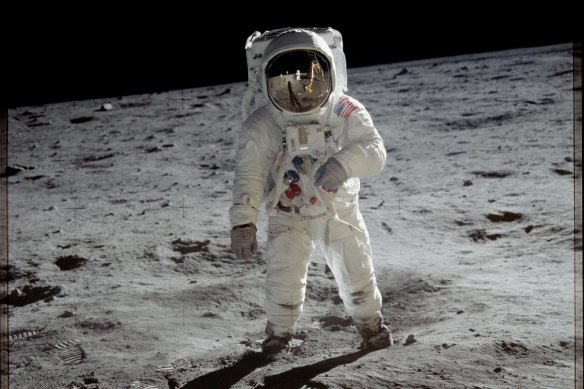
Been there: Apollo 11 astronaut Buzz Aldrin walks on the moon.Credit: NASA
Told there was one minute to go to the firing, Armstrong said to Collins: “See you later.”
“You’ve got a fine looking flying machine there, Eagle,” Collins radioed his colleagues in the landing craft.
Ninety minutes later, a navigational computer fired Eagle’s engine to begin their descent from behind the moon.
Another automatic burn brought the module to a hover point 200 feet above the Sea of Tranquility.
Armstrong, taking manual control, decided to land. At 15 feet, feelers on the legs flashed “contact” on the control panel. Armstrong shut off the rocket motor. Eagle touched down in a cloud of dust at three miles an hour.
The three spacemen began their historic last step a few minutes before midnight.
Aldrin, without his full spacesuit, first crawled into Eagle – the landing ship – to start an exhausting systems check. Commander Armstrong, wearing full spacesuit, joined him an hour later.
Aldrin, excited, later put on his spacesuit and rejoined Armstrong through the 30 in. wide by 18 in. long tunnel which connects the moonship to the mothercraft.
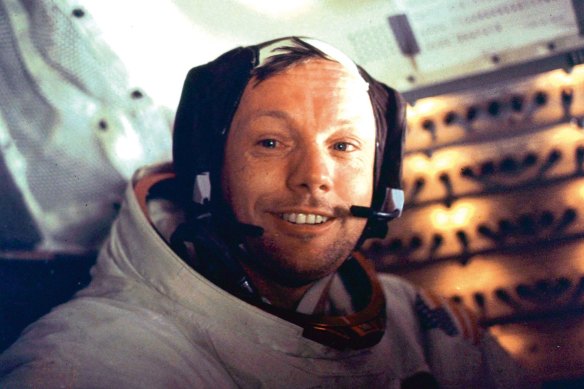
Neil Armstrong is seen smiling at the camera aboard the lunar module "Eagle".Credit: NASA
Sixty miles below them stretched the airless, jagged, hostile face of the moon.
It was just like a bleak winter’s day in Melbourne when the spacemen went in to land.
The moon’s reading was between 40 and 50 degrees (fahrenheit).
First published in The Age on July 22, 1969
HISTORY, THEN HOME
The world’s first moon-men are coming home – with moonrock in their pockets and the praise of the world heaped on their heads.
Astronauts Neil Armstrong, 29, the leader, and Edwin “Buzz” Aldrin, 38, were due to blast off from the moon’s Sea of Tranquility at 3.55 a.m. today.
They will dock with Michael Collins, 38, in the mother ship, Columbia, at 7.28 Melbourne time this morning.
Late last night Armstrong and Aldrin were sleeping in their spaceship on the moon’s surface after their triumphant, historic two-hour walk.
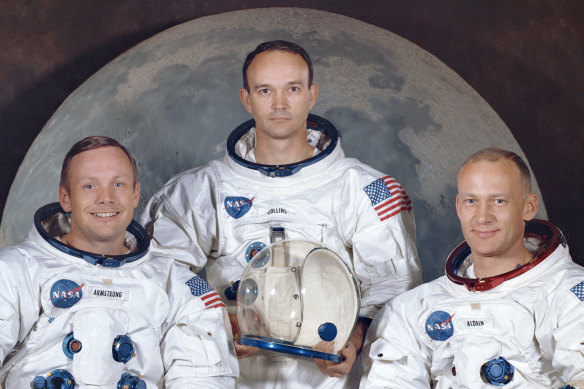
The crew of the Apollo 11, from left, Neil Armstrong, commander; Michael Collins, module pilot; Edwin E. "Buzz" Aldrin, lunar module pilot. Apollo 11 was the first manned mission to the surface of the moon. Credit: NASA via AP
At blast-off they will have been there for nearly 22 hours.
Sixty miles above them Collins was sleeping soundly in the command ship Columbia.
The astronauts will splash down in the Pacific Ocean, south-west of Hawaii at 2.51 a.m. on Friday.
Yesterday 600 million people in 49 countries saw the spacemen take the first moonwalk, plant the American flag, gather moonrock and kangaroo-hop on the surface.
If the flight goes smoothly the astronauts will fire the ascent engines of Eagle – the landing ship – at 3.55 this morning.
Within seven seconds it will zoom into an elliptical orbit – nine miles clear of the moon at its nearest point.
Then, after several hours maneuvering, they will link up with Columbia.
As Melbourne eats breakfast, the astronauts will fire the main engine and the 250,000-mile journey back to Earth will begin.
The spacemen will bring back about 100 lbs. of moon samples.
Behind them will be scientific equipment to carry on man’s work after they have gone.
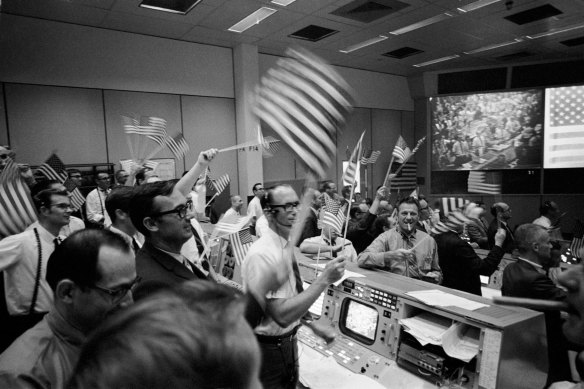
Celebrations on July 24, 1969, at the conclusion of the Apollo 11 mission, from the control room in Houston. Credit: JSC/NASA via The New York Times
‘Now man is little lower than the angels’
Man has become “little lower than the angels” with the historic moon landing and walk.
This was how the “New York Times” saw the achievement of astronauts Armstrong, Aldrin and Collins.
In America, the wives of the spacemen whooped, hollered, laughed and cried.
Mrs. Neil Armstrong said: “I can’t believe its happening. That’s the big step.”
His mother, Mrs. Stephen Armstrong said: “I was worried that they might sink in too deep. But no, they didn’t. So it was wonderful.”
Mrs. Edwin Aldrin laughed and cried and hugged her father. And she went to church.
Her husband, “Buzz”, she said, had taken communion bread to the moon.
The bread had been given to Aldrin by the Rev. Dean Woodruff. So she went to the church to thank him.
Armstrong, Collins and Aldrin may also have a surprise for their wives.
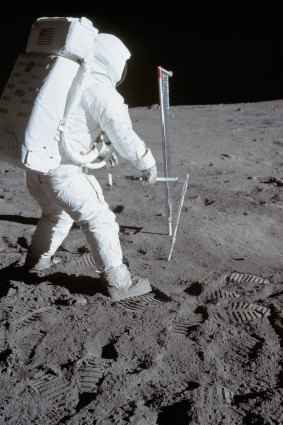
Footprints in the dust: Astronaut Buzz Aldrin during the Apollo 11 extravehicular activity (EVA) on the moon. Credit: NASA
Before they left their wives they said they would bring something back. But just what no one was saying.
Congratulations from world leaders flooded in to the astronauts.
President Nixon spoke direct from the White House to Armstrong and Aldrin as they made their great walk.
“I can’t tell you how proud we all are of you for every American,” he said.
“This has to be the proudest day of our lives.”
The astronauts snapped to attention and saluted as smartly as they could in their bulky, bubble-topped spacesuits.
President Nixon is expected to announce within 60 days that the next U.S. objective is Mars.
The moon landing and walk was broadcast to 500,000 American troops in Vietnam.
Australia’s Prime Minister (Mr. Gorton) went to Honeysuckle Creek tracking station near Canberra.
The proceedings, he said, were “wriggling green lines” and noise.
“I was blinded by the science,” he said.
“I salute all those who have contributed to this great, peaceful achievement.”
In New Zealand, the Prime Minister (Mr. Holyoake) said the trip was a “stupendous voyage of discovery.”
Pope Paul also saluted them and said: “Honor, greetings and blessings to the conquerors of the moon.”
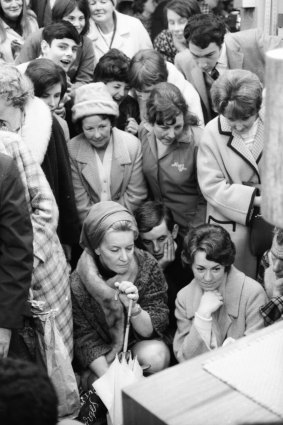
Shoppers packed around every one of the dozens of demonstration TV sets in this big Melbourne store to see the Moon walk.Credit: The Age Archives
And in Houston, a top space official said America may have men living on the moon more or less permanently by 1979.
They would live mush as man lived today on the Antarctica, he said.
The official, the associate administrator of NASA (Dr. John Naulge) made his predictions after the spacemen touched down on the moon.
He said man would next make an instrument landing of Mars, and a grand, unnamed tour of Jupiter, Saturn, Uranus and Neptune.
The astronauts may be bringing back some water from the moon.
Aldrin drove a hollow tub into the moon’s surface during his lunar walk, bringing up a core sample of lunar soil.
He told mission control that the soil seemed almost wet.
If the dirt is wet, it may mean there is life in some form on the moon.
Scientists have said that one of the main reasons they thing the moon is a dead planet is because they believed that there was no water.
Lett than three minutes after the Voice of America started broadcasting news of the Apollo 11 mission to the Soviet Union in Russia last night the frequencies were jammed.
Representatives monitoring the broadcasts in Helsinki, and Vienna, relayed word of the Soviet jamming activity to Washington.
The acting director of the Voice of America (Mr. R. Cushing) said the Russians interrupted the broadcasts by transmitting music-talk cultural programs on the same frequencies.
But English-language broadcasts to the Soviet Union were not hampered, he said.
The Apollo flight surgeon (Dr. Charles Barry) reported that the heart rates of the two astronauts ranged from a low of 90 beats a minute to highs of 125 for Aldrin and 160 for Armstrong.
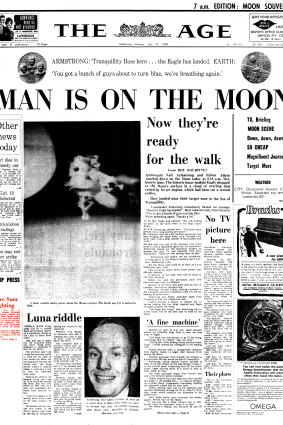
Front page of The Age, July 21, 1969 - MAN IS ON THE MOON. Credit: The Age Archives
Armstrong’s high came as he was loading boxes full of rock samples – about 20 pounds in all – aboard the lunar module.
Moscow television broadcast seven minutes of the moon walk, but in general the Soviet Union maintained its low-key treatment of the Apollo mission.
By the time the recording of the walk was shown on television just after 10 a.m. Moscow time (5 p.m. Melbourne time) the official Tass news agency had devoted a total of five paragraphs to the moon saga.
On television – which last night had virtually ignored Apollo – the news came after a report that Soviet leaders had left for a scheduled visit to Poland.
The keynote of the historic flight and exploration was a typical American mixture of cool efficiency and informality, exemplified by Armstrong
His unflurried reporting of gauges during the perilous descent, his methodical calling of checklists before stepping on the moon, contrasted with informality elsewhere.
The astronauts quickly became “Neil” and “Buzz” in all communications.
“Throttles down better than the simulator,” Armstrong reported “Eagle” plunging moonward.
His laconic “The Eagle has landed,” was for more in character than his shy, nervous attempt to say something historic as he stepped down the LEM’s ladder.
“Be sure not to lock it,” Armstrong later told Aldrin as the second man on the moon crawled out of the hatch of the lunar module” their only link with Earth.
Yet the steel showed in a voice that frequently changed requests to commands.
He soon exercised his commander’s prerogative in advancing the moment of his historic first step on the moon.
Wild cheering broke out at the Houston space centre as the American astronauts touched down on the moon.
Mrs. Barbara Apine, the Australian wife of the NASA director said she and her husband sat on either side of astronaut Tom Stafford in the control centre.
They rode “Eagle” down to the moon “every foot of the way.”
Man conquered the moon with consummate ease.
The gravest, but momentary, peril came when Armstrong had to skillfully avoid a large jagged crate and land in a smooth area “down range”.
“Hang tight,” he said calmly as he went down.
Cartographers are still trying to pinpoint accurately the historic touchdown site in the Sea of Tranquility.
Armstrong’s famous first quotations included “Houston Tranquility base here. The Eagle has landed.”
And as he stepped onto the surface of the moon 6 ½ hours later: “It’s one small step for man. One great leap for mankind.”
The landing was advanced four hours, partly due to their understandable impatience, and partly due to the urging of American television networks.